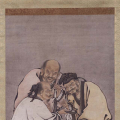Welcome home! Please contact lincoln@icrontic.com if you have any difficulty logging in or using the site. New registrations must be manually approved which may take several days. Can't log in? Try clearing your browser's cookies.
Lankavatra Sutras comments on what a Buddha is
 Jeffrey
Veteran
Jeffrey
Veteran
in Philosophy
http://lirs.ru/do/lanka_eng/lanka-nondiacritical.htm
The Classification of BeingsMore info at the citation I linked
From the Mahayana point of view, beings are divisible into two heads: those that are enlightened and those that are ignorant. The former are called Buddhas including also Bodhisattvas, Arhats, and Pratyekabuddhas while the latter comprise all the rest of beings under the general designation of bala or balaprithagjana—bala meaning "undeveloped", "puerile", or "ignorant", and prithagjana "people different" from the enlightened, that is, the multitudes, or people of ordinary type, whose minds are found engrossed in the pursuit of egotistic pleasures and unawakened to the meaning of life. This class is also known as Sarvasattva, "all beings" or sentient beings. The Buddha wants to help the ignorant, hence the Buddhist teaching and discipline.
1 Published by George Routledge and Sons, London. 1930. Pp. xxxii+464.
The Buddha
All the Buddhist teachings unfold themselves around the conception of Buddhahood. When this is adequately grasped, Buddhist philosophy with all its complications and superadditions will become luminous. What is the Buddha?
According to Mahamati the Bodhisattva-Mahasattva, who is the interlocutor of the Buddha in the Lanka, the Buddha is endowed with transcendental knowledge (prajna) and a great compassionate heart (karuna). With the former he realises that this world of particulars has no reality, is devoid of an ego-substance (anatman) and that in this sense it resembles Maya or a visionary flower in the air. As thus it is above the category of being and non-being, it is declared to be pure (visuddha) and absolute (vivikta) and free from conditions (animitta). But the Buddha's transcendental wisdom is not always abiding in this high altitude, because being instigated by an irresistible power which innerly pushes him back into a region of birth and death, he comes down among us and lives with us, who are ignorant and lost in the darkness of the passions (klesa). Nirvana is not the ultimate abode of Buddhahood, nor is enlightenment. Love and compassion is what essentially constitutes the self-nature of the All-knowing One (sarvajna).
The Buddha as Love
The Buddha's love is not something ego-centered. It is a will-force which desires and acts in the realm of twofold egolessness, it is above the dualism of being and non-being, it rises from a heart of non-discrimination, it manifests itself in the conduct of purposelessness (anabhogacarya). It is the Tathagata's great love (mahakaruna) of all beings, which never ceases until everyone of them is happily led to the final asylum of Nirvana; for he refuses as long as there is a single unsaved soul to enjoy the bliss of Samadhi to which he is entitled by his long spiritual discipline. The Tathagata is indeed the one who, endowed with a heart of all-embracing love and compassion, regards all beings as if they were his only child. If he himself enters into Nirvana, no work will be done in the world where discrimination (vtkalpa) goes on and multitudinousness (vicitrata) prevails. For this reason, he refuses to leave this world of relativity, all his thoughts are directed towards the ignorant and suffering masses of beings, for whom he is willing to sacrifice his enjoyment of absolute reality and self-absorption (samadhi-sukhabhutakotya vinivarya).
Skilful Means
The essential nature of love is to devise, to create, to accommodate itself to varying changing circumstances, and to this the Buddha's love is no exception. He is ever devising for the enlightenment and emancipation of all sentient beings. This is technically known as the working of Skilful Means (upayakausalya). Upaya is the outcome of Prajna and Karuna. When Love worries itself over the destiny of the ignorant, Wisdom, so to speak, weaves a net of Skilful Means whereby to catch them up from the depths of the ocean called Birth-and-Death (samsara). By Upaya thus the oneness of reality wherein the Buddha's enlightened mind abides transforms itself into the manifoldness of particular existences.
There is a gem known as Mani which is perfectly transparent and colourless in itself, and just because of this characteristic it reflects in it varieties of colours (vicitra-rupa). In the same way the Buddha is conceived by beings; in the same way his teaching is interpreted by them; that is, each one recognises the Buddha and his teaching according to his disposition (asaya), understanding (citta), prejudice (anusaya), propensity (adhimukti), and circumstance (gati). Again, the Buddha treats his fellow-beings as an expert physician treats his patients suffering from various forms of illness. The ultimate aim is to cure them, but as ailments differ medicines and treatments cannot be the same. For this reason it is said that the Buddha speaks one language of enlightenment, which reverberates in the ears of his hearers in all possible sounds. Upaya may thus be considered in a way due to the infinite differentiation of individual characters rather than to the deliberate contrivance of transcendental wisdom on the part of the Buddha.
One Buddha with Many Names
All the Buddhas are of one essence, they are the same as far as their inner enlightenment, their Dharmakaya, and their being furnished with the thirty-two major and the eighty minor marks of excellence are concerned. But when they wish to train beings according to their characters, they assume varieties of forms appearing differently to different beings, and thus there are many titles and appellations of the Buddha as to be beyond calculation (asamkhyeya).
One noteworthy fact about this—the Buddha's assuming so many names, is that he is not only known in various personal names but also given a number of abstract titles such as No-birth, Emptiness, Suchness, Reality, Nirvana, Eternity, Sameness, Trueness, Cessation, etc. The Buddha is thus personal as well as metaphysical.
The Lanka here does not forget to add that though the Buddha is known by so many different names, he is thereby neither fattened nor emaciated, as he is like the moon in water neither immersed nor emerging. This simile is generally regarded as best describing the relation of unity and multiplicity, of one absolute reality and this world of names and forms.
Transformation-bodies of the Buddha
While the Trikaya dogma is not yet fully developed in the Lanka, each member of the trinity is treaceable in such ideas as Dharmata-buddha, Vipaka-buddha, and Nirmana-buddha. The notion of the transformation-body inevitably follows from the Buddha's desire to save the ignorant whose minds are not enlightened enough to see straightway into the essence of Buddhahood. As they are not clear-sighted, something is to be devised to lead them to the right path, and this something must be in accord with their mentalities. If not, they are sure to go astray farther and farther. If they are not capable of grasping Buddhata as it is, let them have something of it and gradually be developed. The theory of Upaya (skilful means) is also the theory of Manomayakaya, will-body. As the incarnation of a great compassionate heart, the Buddha ought to be able to take any form he wishes when he sees the sufferings of sentient beings. The will-body is a part of the Buddha's plan of world-salvation. This is one of the reasons why Buddhism is often regarded as polytheistic and at the same time pantheistic.
2


Comments
I believe in the Pali Canon it is an imponderable where the Buddha goes after parinirvana (or something like that).
I thought it was the same in Mahayana since Chapter 1 (Introduction) of the Nirvana Sutra also provides an account of the Buddha's entering into nirvana.
I like to think that the Buddha can help us in our lives. It does raise warning bells regarding if that is like Christianity which many Buddhists are critical of or trying to get away from. Still I take prayer as 'opening' to the Buddhas and in that effect I can perceive in my own experience that I AM open. That doesn't mean Buddha makes miracles for me though remembering some of the dumb things I did as a dopamine filled youth surely there must have been some miracles to keep my dumb ass alive.
Actually the text I quoted is not from the Lankavatra Sutra itself, but it is from the translator's own introduction to the sutra. He says that the introduction is meant to serve as one for Mahayana Buddhism generally and he doesn't cite any sources for the information he provides. Therefore, when he says that the Buddha refuses to enter into nirvana, that seems to be his own understanding and I think we should not assume that it has anything do with the Lankavatra Sutra or any other sutras.
In fact there are several passages in the Lankavatra Sutra that talks about the Buddha entering into nirvana, eg.:
However, there are some passages in the Lankavatra Sutra that speaks at the level of ultimate reality being emptiness and in that context it is said that nirvana does not exist and thus there is no such thing as entry into nirvana, eg. But the text I quoted from the translator's own introduction was not being made from the perspective of ultimate reality so I believe it departs from what is being said in the Lankavatra Sutra as well as the Nirvana Sutra. Thus it is the translator's own personal view which is inconsistent with the sutras while there seems to be no inconsistency whatsoever between the Lankavatra Sutra and Nirvana Sutra.
I also want to point out that in the Theravada tradition, a teaching Buddha such Gautama is always born as a mortal human being. He discovers the path towards enlightenment on his own and by such virtue becomes a teaching Buddha. As a mortal human being he must eventually pass away and, because of his enlightenment, automatically enters nirvana, ie. there is no choice to refuse entry into nirvana because the Buddha has, through his enlightenment, extinguished all causes for any future rebirth. However, when the Buddha was a Boddhisattva in one of his past lives, he did, out of his great compassion, refuse to enter into Nirvana so that he may develop the perfections over the incalculable zillions of years in order to become a teaching Buddha which he finally did achieve. I briefly recounted Buddha Gautama's story in this post in a previous thread. Absolutely, the Buddha and his teachings are certainly alive in the hearts and minds of Buddhists all over the world despite his entering nirvana. When I do pray to the Buddha I feel as if he is able to hear my prayers. In the most difficult of times, this can certainly be a source of comfort.
I'll take your word on the Lankavatra sutra that the translator may have tripped up, but I'll take it with a grain of salt because the translator isn't here at NB to explain where he is coming from.
From my perspective the Buddha is not only a source to call to in difficult times but also there is the trikaya. Shakyamuni manifested to most of us as nirmanakaya as a human. But at the Bodhisattva level the student perceives the samboghakaya or enjoyment body of Buddha. I suppose somewhere along the way to enlightenment the dharmakaya is perceived and aligned with.